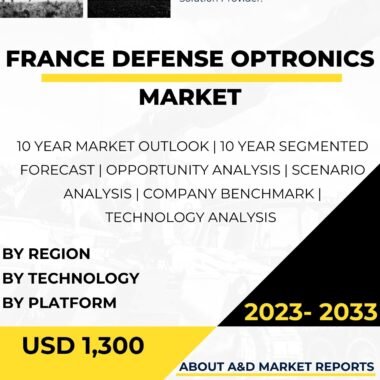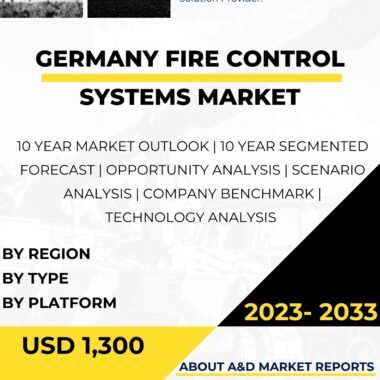Description
In the United States’ defense industry, optronics, also known as electro-optics, play a critical role in providing advanced optical and electronic systems that enhance military capabilities across various domains. Optronics is the fusion of optics and electronics, encompassing technologies that utilize light and other electromagnetic radiation for imaging, sensing, and communication purposes. These technologies have significantly impacted defense operations by enabling improved surveillance, target acquisition, situational awareness, and precision-guided systems. This article will explore the development, types, applications, and significance of defense optronics in supporting the nation’s defense capabilities and maintaining a technological edge in the modern battlefield.
The development of defense optronics in the United States has been driven by the need for advanced sensing and imaging technologies in military operations. Early applications of optronics in defense included night vision devices and imaging sensors for reconnaissance and surveillance. Over time, advancements in materials science, sensor technology, and signal processing have expanded the capabilities of optronics systems, leading to a diverse range of applications in defense.
One of the primary applications of defense optronics is in electro-optical and infrared (EO/IR) sensors. EO/IR sensors combine visible light and infrared imaging technologies to provide day and night surveillance capabilities. These sensors are integrated into various platforms, including unmanned aerial vehicles (UAVs), aircraft, ground vehicles, and maritime vessels, enabling real-time situational awareness and target detection.
In the context of military operations, EO/IR sensors are vital for intelligence, surveillance, and reconnaissance (ISR) missions. They allow military forces to gather critical information about enemy movements, monitor border areas, and track potential threats in challenging environments.
Another key application of defense optronics is in targeting and precision-guided systems. Laser designators and rangefinders are examples of optronics technologies used to guide munitions, such as laser-guided bombs and missiles, to their targets with high accuracy. These systems improve the effectiveness of military strikes while minimizing collateral damage.
Moreover, optronics play a crucial role in enhancing soldiers’ capabilities on the ground. Head-mounted displays with integrated night vision and thermal imaging technologies provide soldiers with increased situational awareness in low-light conditions. This allows for safer and more effective operations during nighttime and in obscured environments.
Beyond EO/IR sensors, defense optronics include various other technologies that support military operations. Lidar (Light Detection and Ranging) systems, for instance, use laser pulses to measure distances and generate detailed 3D maps of terrain, enabling accurate navigation and target recognition.
Furthermore, optronics systems are integral components of electronic warfare (EW) and countermeasures. Infrared countermeasures, such as flares and decoys, utilize optronics to disrupt and confuse incoming missiles that rely on infrared signatures for target acquisition.
The significance of defense optronics lies in its transformative impact on military capabilities and operational effectiveness. By providing advanced sensing and imaging technologies, optronics enhance situational awareness, enabling military forces to make better-informed decisions on the battlefield.
Defense optronics also contribute to the development of precision-guided systems, reducing the risk to both military personnel and civilian populations during military operations. The ability to accurately target and engage threats with minimal collateral damage enhances the ethical and legal aspects of military actions.
Furthermore, optronics technologies give the U.S. military a decisive advantage in modern warfare scenarios. As the battlefield becomes increasingly asymmetric and complex, the use of optronics provides a technological edge, enabling U.S. forces to detect, track, and engage adversaries effectively.
The ongoing development and advancement of defense optronics involve continuous research and investment in various areas. The U.S. Department of Defense (DoD) collaborates with defense contractors, research institutions, and universities to enhance optronics capabilities, address emerging challenges, and drive innovation.
Advancements in sensor miniaturization and integration have led to the development of compact and lightweight optronics systems, making them more suitable for use in unmanned platforms and individual soldier equipment.
Moreover, research focuses on improving the resolution, sensitivity, and dynamic range of optronics sensors, allowing for clearer and more detailed imaging in a variety of environmental conditions.
Challenges in the development of defense optronics include mitigating the effects of environmental factors, such as adverse weather and atmospheric conditions, on sensor performance. Research is ongoing to develop algorithms and signal processing techniques to enhance sensor performance in challenging environments.
Additionally, efforts are made to improve the power efficiency of optronics systems to extend the operational endurance of battery-powered devices, such as UAVs and soldier-worn equipment.
Furthermore, the U.S. military seeks to maintain its technological edge in optronics amidst increasing global competition. Strategic investments in research and development are essential to ensure that the U.S. Armed Forces remain at the forefront of optronics capabilities and maintain a technological advantage over potential adversaries.
In conclusion, defense optronics is a critical component of the United States’ defense capabilities, providing advanced sensing, imaging, and communication technologies for military applications. These technologies play a key role in intelligence, surveillance, reconnaissance, targeting, precision-guided systems, electronic warfare, and soldier systems.
The versatility and effectiveness of defense optronics enhance military situational awareness, decision-making, and precision strike capabilities, supporting the nation’s defense objectives in an ever-evolving and complex security landscape.
The ongoing development and advancement of defense optronics involve continuous research, investment, and collaboration among industry stakeholders, research institutions, and government agencies. By leveraging the transformative potential of optronics technologies, the U.S. Department of Defense can maintain its technological edge, ensure the safety of military personnel, and enhance the effectiveness of military operations.




